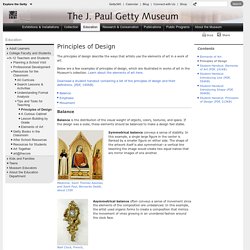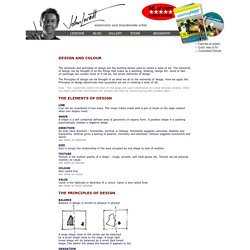

Understanding Formal Analysis. Discover how to analyze the formal aspects of a work of art by learning about the elements of art and principles of design that are used by artists working in various media. Students who can identify the elements and principles and evaluate their role in the composition of a work of art will be better able to understand an artist's choices. They will be equipped to address whether a work of art is successful, and why.
The list below describes each element of art. Understanding Formal Analysis. The principles of design describe the ways that artists use the elements of art in a work of art.

Below are a few examples of principles of design, which are illustrated in works of art in the Museum's collection. Learn about the elements of art here. Download a student handout containing a list of the principles of design and their definitions. (PDF, 190KB) Balance is the distribution of the visual weight of objects, colors, textures, and space. Symmetrical balance conveys a sense of stability. Asymmetrical balance often conveys a sense of movement since the elements of the composition are unbalanced. Emphasis is the part of the design that catches the viewer's attention. In this sculpture, the central figure stands out due to his relative size and position above the other figures. Movement is the path the viewer's eye takes through the work of art, often to focal areas. In this photograph the diagonal lines lead the eye into the space to the point where the lines converge. The Elements of Art- Shape and Form.
A shape is created when a line is enclosed. Shape is one of the seven elements of art and it has a variety of uses in the creation of art. Shape is a two-dimensional area that is defined by a change in value or some other form of contrast. All shapes are two-dimensional, meaning that they have only length and width. All shapes will fall into one of two categories. Geometric shapes or regular shapes are easy to recognize. Organic or freeform shapes are shapes that seem to follow no rules. We can learn to see the world around us as shapes. Shapes defined by objects are positive shapes (space). The relationships between the positive and negative shapes help the brain of our viewers understand what they are seeing.
By organizing geometric and organic shapes, we can draw anything. Terms Shape- an element of art that is a two-dimensional area that is defined in some way. Geometric shapes- precise shapes that can be described using mathematical formulas. Form and Shape are related. Elements & Principles of Design. Elements and principles of design. The elements and principles of design are the building blocks used to create a work of art.

The elements of design can be thought of as the things that make up a painting, drawing, design etc. Good or bad - all paintings will contain most of if not all, the seven elements of design. The Principles of design can be thought of as what we do to the elements of design. How we apply the Principles of design determines how successful we are in creating a work of art. note - the hyperlinks within the text of this page will open information in a new browser window. LINE Line can be considered in two ways. SHAPE A shape is a self contained defined area of geometric or organic form. DIRECTION All lines have direction - Horizontal, Vertical or Oblique.
SIZE Size is simply the relationship of the area occupied by one shape to that of another. TEXTURE Texture is the surface quality of a shape - rough, smooth, soft hard glossy etc. COLOUR Also called Hue see notes on colour.